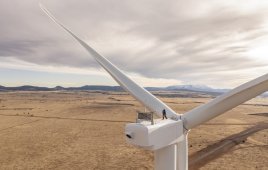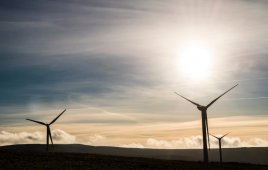A California-based consulting firm recently conducted a study of the U.S. patent landscape for wind turbines to determine which technological trends have emerged and what might be in store for the future of wind-turbine technology. The study, from Totaro & Associates (www.totaro-associates.com), focuses on the most prevalent sector of the industry–utility-scale, horizontal-axis wind turbines.
The study involved searching and aggregating relevant results using keyword classifications, then analyzing the results to identify a degree of relevancy to the industry for each patent. “We found and analyzed over 1,700 patents just in the U.S.,” says company Principal Phillip Totaro.
His initial conclusion is that most of today’s wind patents solve yesterday’s problems. “Most patents are directed towards blades, electrical systems, and generators,” he says. “These components required the most quality, efficiency, and reliability enhancements in the past 10 to 15 years.”
Controls and sensors, however, recently jumped towards the top of the list of patented wind components. This signals a shift in focus towards performance improvements, load mitigation, and grid integration in the coming years.
“Based on more recent patent application filings, as well as an analysis of forward-looking industry competitive intelligence, we recognized several future technology trends as well,” says Totaro. New technologies and their patents will likely be directed towards six core areas.
1. Reducing component weight and manufacturing costs: Component weight and cost reduction stem from a goal to maintain a tower-head-mass ratio (mass per annual kWhr produced) which is comparable to or better than today’s equipment.
“Most OEMs equate mass with cost in their competitive cost-of-energy benchmarking, and rightly so given the expense of commodities,” says Totaro. “As a result, many wind-turbine manufacturers have introduced ‘cost-out’ programs in recent years. Expect these projects to lead to cost-cutting innovations for which top-tier OEMs will look to capture IP.”
2. Transport and assembly: This relates to mass and cost concepts, as well as physical transportation constraints, which exist for land-based systems. Mass increases with component size, especially in light of larger-turbine developments. However, excessive mass or size incurs excessive transportation costs. Advanced modeling tools and manufacturing methods can predict failure modes and reduce the amount of materials used, while ensuring better quality control.
“What’s more, blades with large root diameters or towers with base diameters more than about 4.3m will face onshore transportation hurdles,” says Totaro. While it is possible to manufacture such structures, more material will be required to reinforce them, which is not the best solution in a cost-competitive industry. Hence, the segmentation of towers and blades, as well as “on site” assembly procedures and tooling fixtures, are likely to become significantly important. Proactive manufactures have already captured some of the core intellectual property in this area.
3. Monitoring and control: The third trend relates to fleet-management technology, which centers around condition monitoring and control of turbines and wind farms. While the first two trends focused on reducing energy costs from the capital side of the equation, this trend is based on minimizing recurring O&M costs.
“Technologies such as condition-monitoring systems are being investigated and deployed,” says Totaro. “These determine the ‘health’ of individual turbines as well as their components. Condition monitoring could be combined with control systems for maximum turbine output for wind conditions.”
It is important to OEMs and owner-operators of wind farms to run turbines so as to mitigate unscheduled maintenance as well as planning scheduled maintenance to maintain as much on-line capacity and up-time as possible.
4. Turbine Reliability: Drivetrain architecture and component reliability will remain an ongoing issue as OEMs now quote 97 to 98% availability in their supply agreements. Totaro says, “We have seen and will continue to see OEMs investigating direct drive and other hybrid gearbox and generator designs.”
Yet, Totaro suggests taking caution on this trend and the pervasive deployment of direct-drive turbines in particular, “Some owner-operators of wind farms seem to have the OEMs convinced that gearbox driven designs are unreliable and direct drive is the answer, since there is no gearbox to fail,” he explains. “But the jury is still out on the underlying reliability of this technology.” Ongoing work by the National Renewable Energy Laboratory (NREL) in Boulder, Colorado has identified key issues with gearboxes now that we have a dearth of data, and the solutions to those challenges are being incorporated into new designs all the time.
5. Grid integration: Better integration and a move towards the “grid-friendly” turbine is already underway. Turbines with induction generators have made it costly and difficult to accomplish low-voltage ride through or handle “black starts,” those in which the grid is not present. Of particular interest are technologies based on providing ancillary turbine services as well as VAR support to the grid. Totaro says, “Wind farm operators want to operate the wind farm like a gas turbine plant, but the wind is stochastic and it makes control difficult, but not impossible.”
Permanent-magnet-synchronous generators (PMSGs) improve efficiency and performance without sacrificing much in the variable-speed range. More use of the technology is likely to continue says Totaro, “Of the last 11 ‘clean sheet’ turbine designs to be introduced into the global market in the past two to three years, nine of them were PMSGs.”
6. Optimizing performance: Lastly, wind turbine and wind-farm performance improvements will continue. “This is something we have termed ‘max energy output, all the time,’” says Totaro. Controls for curtailment and “up-rating” due to prevailing conditions are actively being investigated by multiple OEMs. Also, combining condition monitoring with control systems will help determine the remaining useful life in components and operate the turbine to its maximum potential without incurring further damage.
Whatever the future may actually hold, the promise of clean energy from wind is here to stay. Innovation continues to drive change. The full study is available at www.totaro-associates.com/articles.
WPE
Filed Under: Turbines





